Source: Grayscale; Translated by: Baishui, Jinse Finance
Summary
In July, cryptocurrency became a more prominent topic in the U.S. presidential debates as the Republican candidate spoke at a major Bitcoin conference, and Democrats were reportedly considering a “reboot” of the industry. Earlier this year, a Harris Poll conducted on behalf of Grayscale highlighted the importance of the cryptocurrency voting bloc, and Grayscale Research is pleased to see bipartisan attention paid to cryptocurrency policy issues.
The campaign also drew attention to former President Trump’s views on the dollar (he may have favored weakness to support manufacturing).
Separately, a spot Ethereum ETP was launched in the U.S. market; these products had a combined trading volume of approximately $6 billion in the first seven trading days.[1]
While cryptocurrency returns were mixed in July, we believe that current macro trends are increasingly favorable for the crypto asset class.
Despite mixed price performance in July 2024, the crypto industry appears to have taken a major step forward with the launch of a spot Ethereum exchange-traded product (ETP) and Republican presidential candidate and former President Trump’s strong support for Bitcoin. Together, these developments could help expand public blockchain adoption over time.
Volatility increased across financial markets as the shifting macro outlook upended several popular investment themes. For example, large-cap technology and AI-related stocks[2] have significantly underperformed after leading the market in the first half of 2024. In contrast, homebuilders, regional banks, and small-cap stocks have outperformed after disappointing returns at the beginning of the year (Figure 1). The rotation appears to have been triggered by rising expectations for Federal Reserve rate cuts and improved polling for former President Trump following the July 13 assassination attempt. Cryptocurrencies have had mixed performance this month: Bitcoin is up about 7% and Ethereum is down about 5%; both are middling on a risk-adjusted basis.
Figure 1: Crypto gains mixed with equity rotation
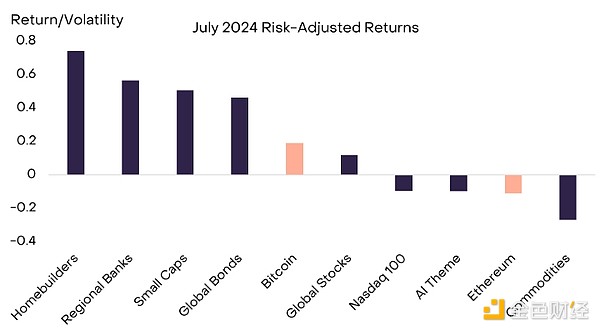
Bitcoin’s relatively strong performance this month means that Bitcoin’s dominance (the ratio of its market capitalization to the total cryptocurrency market capitalization) continues to trend upward (Chart 2). This may in part reflect steady inflows into the asset: US-listed spot Bitcoin ETPs saw net inflows of around $3 billion in July, with cumulative inflows now totaling over $18 billion since launch. Notably, news reports suggest that some of these inflows reflect purchases by public sector pension funds, an encouraging sign of institutional adoption. [3] Additionally, the German government ended its Bitcoin sell-off on July 13, which may have contributed to the subsequent price recovery. [4] Meanwhile, distributions from Mt Gox, a failed cryptocurrency exchange, appear to have had limited impact on Bitcoin’s price. Mt Gox distributions began on July 4 and began appearing in user accounts on centralized exchanges on July 23, but there is no evidence that this triggered a major sell-off.
Figure 2: Bitcoin’s dominance is still on an upward trend
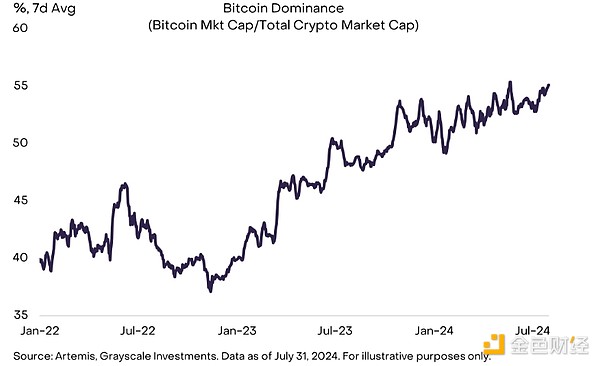
In terms of the longer-term outlook, we believe that the more important developments in July were former President Trump’s acceptance of Bitcoin and cryptocurrencies, and a potential change in the views of some Democratic leaders on cryptocurrencies. For example, at the Bitcoin 2024 conference in Nashville, Trump stated that he intends to be “the pro-innovation, pro-Bitcoin president that America needs and our citizens deserve.” He also defended the right to self-custody and stated that if he is elected, the U.S. government would “retain 100% of all Bitcoin currently held or acquired by the U.S. government in the future.” [5] Trump’s efforts to woo cryptocurrency voters could also prompt a change in the Democratic Party’s cryptocurrency strategy. For example, the Financial Times reported last week that Vice President Harris’s advisers have reached out to major cryptocurrency companies to “reset” relationships. [6] Whether this leads to a change in policy remains to be seen, but bipartisan support for the industry in Washington could support the adoption and development of public blockchain technology.
In addition to courting crypto voters, aspects of Trump’s campaign policy platform could have an impact on Bitcoin’s valuation. Both Trump and his running mate, Senator JD Vance, have previously expressed a desire for a weaker dollar to support domestic manufacturing (a weaker dollar can make U.S. exports more competitive in international markets). [7] Today, the dollar is highly valued on standard metrics: its real (inflation-adjusted) trade-weighted value is at the 98th percentile of its historical range (Exhibit 3). Bitcoin is an alternative store of value asset that could compete with the dollar for this role. Therefore, a continued depreciation in the value of the dollar could support Bitcoin as well as other store of value assets such as physical gold.
Figure 3: The value of the US dollar is at a historical high

The U.S. presidential election has also put a spotlight on Polymarket, a decentralized prediction market built on the Polygon blockchain that allows users to buy and sell future outcomes of events using stablecoins (Polygon is part of the smart contract platform’s crypto division). Polymarket uses blockchain technology to ensure that transactions on a wide range of topics, including current events, politics, and public health issues, are transparent, secure, and tamper-proof. The platform has recently seen significant growth, with $387 million in trading volume in July alone. [8] The platform has also become an effective barometer of public sentiment on the probability of various events, including the debate within the Democratic Party over whether to replace President Biden as its nominee (Figure 4). Earlier this year, Polymarket raised $45 million in Series B funding with support from Vitalik Buterin and Peter Theil’s Founders Fund. [9] Former CFTC Chairman J. Christopher Giancarlo serves as chairman of its advisory board, and journalist and statistician Nate Silver recently joined as an advisor. [10]
Figure 4: Polymarket showcases decentralized applications
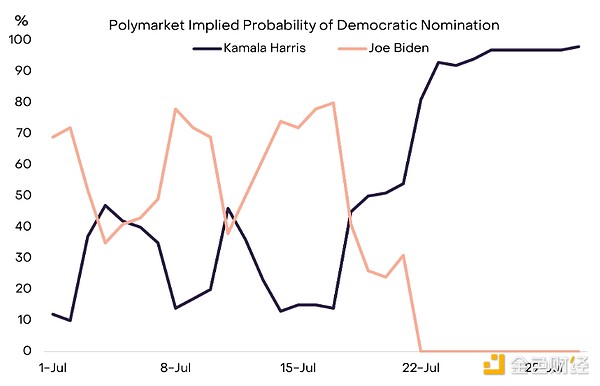
In addition to a host of political developments, July also marked the start of trading of Ethereum spot ETPs in the U.S. market. In the first seven trading days, these nine products saw trading volume of approximately $6 billion. Compared to the first seven trading days of the Bitcoin ETP (which launched in January), the new Ethereum products saw 30% of the volume traded, or roughly the difference in market capitalization between the two assets (Ethereum currently accounts for 30% of Bitcoin’s market capitalization). [11] These nine products saw net outflows immediately after their launch. The decline in Ethereum’s price following the launch of these products may in part reflect these outflows. However, the decline in Ethereum’s price was also associated with the decline in technology stocks, so a general decline in investor risk appetite may also have contributed to this phenomenon (Chart 5).
Figure 5: Ethereum declines correlate with technology stocks
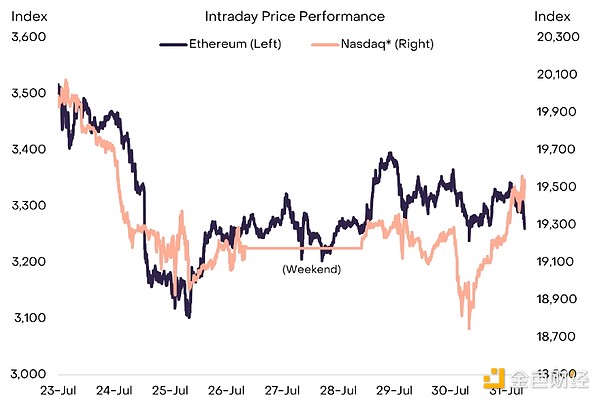
Grayscale’s Crypto Industry Framework highlights that digital asset returns remain highly concentrated. For example, Exhibit 6 compares Bitcoin’s year-to-date returns to our Crypto Industry Market Index (CSMI). The CSMI weights tokens by the square root of their market capitalization to reduce Bitcoin’s weight and better represent the entire market. While Bitcoin is up nearly 50% since the beginning of the year, the CSMI is actually down slightly. For investors who believe a cryptocurrency market recovery could extend beyond Bitcoin, the broader market’s relatively depressed valuations could represent an attractive entry point.
Figure 6: Bitcoin has significantly outperformed the broader cryptocurrency market
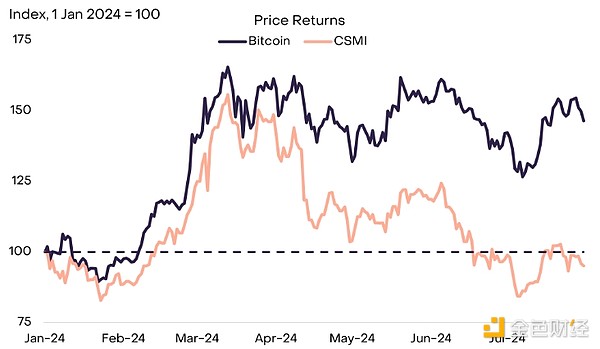
In addition to Bitcoin, another standout performer in July was Solana, which gained 18% in July. Solana’s daily active addresses increased from 1.4 million to 2.3 million, indicating increased user engagement. Its total value locked (TVL) grew from $3.6 billion to $5.5 billion, and its DEX trading volume grew from $1.1 billion to $1.9 billion. These metrics highlight Solana’s growing adoption and market influence, pushing its market cap to nearly $85 billion, close to its all-time high. [12]
Bitcoin and cryptocurrencies have always had the potential to feature in this year’s U.S. election, though former President Trump is now placing more focus on the issue. Earlier this year, The Harris Poll surveyed likely voters on behalf of Grayscale. The results highlighted macroeconomic trends driving digital asset adoption and the growing maturity of the asset class. For example, in the second phase of our survey, voters said they were paying more attention to Bitcoin due to geopolitical tensions, inflation, and dollar risk. Additionally, nearly half of voters (47%) now expect to include cryptocurrencies in their portfolios. In our view, no political party can afford to ignore this increasingly important voting bloc, and Grayscale Research is hopeful that cryptocurrency legislation will receive bipartisan attention in the next Congress.
Despite range-bound valuations over the past month, we believe current macro trends are increasingly favorable for the crypto asset class. Bitcoin has become an important topic in the U.S. presidential election, with the future White House likely to actively support a weaker dollar and the Federal Reserve appearing ready to cut interest rates. Taken together, Grayscale Research believes there is a strong case for Bitcoin to retest its all-time highs later this year.
references
[1] The first seven trading days are the working days between July 23, 2024 and July 31, 2024.
[2] AI-related stocks refer to the AI themes shown in Exhibit 1 (Indxx AI and Big Data).
[3] Source: Reuters, CoinDesk.
[4] Source: Arkham Intelligence data.
[5] Source: Bitcoin Magazine video.
[6] Source: Financial Times.
[7] Source: The New York Times.
[8] Source: Dune Analytics. Data as of July 31, 2024.
[9] Source: The Block.
[10] Source: The Block, Axios.
[11] Source: Bloomberg, Artemis, Grayscale Investments. Data as of July 31, 2024. For illustrative purposes only.
[12] Source: Artemis. Data as of July 31, 2024.







